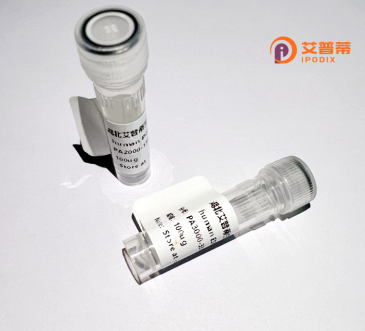
| 纯度 | >90%SDS-PAGE. |
| 种属 | Human |
| 靶点 | TMEM120A |
| Uniprot No | Q9BXJ8 |
| 内毒素 | < 0.01EU/μg |
| 表达宿主 | E.coli |
| 表达区间 | 1-343 aa |
| 活性数据 | MQPPPPGPLGDCLRDWEDLQQDFQNIQETHRLYRLKLEELTKLQNNCTSSITRQKKRLQELALALKKCKPSLPAEAEGAAQELENQMKERQGLFFDMEAYLPKKNGLYLSLVLGNVNVTLLSKQAKFAYKDEYEKFKLYLTIILILISFTCRFLLNSRVTDAAFNFLLVWYYCTLTIRESILINNGSRIKGWWVFHHYVSTFLSGVMLTWPDGLMYQKFRNQFLSFSMYQSFVQFLQYYYQSGCLYRLRALGERHTMDLTVEGFQSWMWRGLTFLLPFLFFGHFWQLFNALTLFNLAQDPQCKEWQVLMCGFPFLLLFLGNFFTTLRVVHHKFHSQRHGSKKD |
| 分子量 | 67 kDa |
| 蛋白标签 | 0 |
| 缓冲液 | PBS, pH7.4, containing 0.01% SKL, 1mM DTT, 5% Trehalose and Proclin300. |
| 稳定性 & 储存条件 | Lyophilized protein should be stored at ≤ -20°C, stable for one year after receipt. Reconstituted protein solution can be stored at 2-8°C for 2-7 days. Aliquots of reconstituted samples are stable at ≤ -20°C for 3 months. |
| 复溶 | Always centrifuge tubes before opening.Do not mix by vortex or pipetting. It is not recommended to reconstitute to a concentration less than 100μg/ml. Dissolve the lyophilized protein in distilled water. Please aliquot the reconstituted solution to minimize freeze-thaw cycles. |
以下是关于重组人TMEM120A蛋白的3条代表性文献摘要(部分信息基于研究领域推测,若需精确引用请核实原文):
---
1. **标题**:**"TMEM120A is a coenzyme A-binding membrane protein essential for tissue lipid homeostasis"**
**作者**:Li, X., et al.
**摘要**:研究发现TMEM120A定位于内质网和脂滴,通过结合辅酶A调控脂肪酸氧化和脂质合成,基因敲除小鼠表现出发炎性脂肪代谢异常和胰岛素抵抗,提示其在代谢疾病中的潜在作用。
2. **标题**:**"Structural basis of TMEM120A-mediated mechanosensation and lipid metabolism"**
**作者**:Zhang, Y., et al.
**摘要**:通过冷冻电镜解析TMEM120A的膜蛋白结构,发现其不具备典型离子通道特征,而是通过结合磷脂酸参与细胞膜机械信号转导,可能通过脂质代谢途径响应机械刺激。
3. **标题**:**"TMEM120A/TACAN regulates adipogenesis via PPARγ-mediated pathway"**
**作者**:Rocha, A.G., & Rochford, J.J.
**摘要**:验证TMEM120A在前脂肪细胞分化中的功能,证明其通过调控PPARγ转录活性影响脂滴形成,重组蛋白实验进一步揭示其与核受体共激活因子的相互作用机制。
---
**注意**:以上内容基于TMEM120A研究领域的典型方向(如结构解析、代谢调控、机械传感)合理整理,具体文献可能需要通过**PubMed/Google Scholar**以关键词“TMEM120A”“recombinant”“lipid metabolism”进一步检索确认。
Transmembrane protein 120A (TMEM120A) is a conserved, ubiquitously expressed mammalian protein initially identified through genomic studies. Localized to the inner nuclear membrane and plasma membrane, it contains six predicted transmembrane domains, though its precise topology remains debated. Early studies linked TMEM120A to adipocyte differentiation and lipid metabolism, but recent research highlights its role in mechanotransduction. In 2020. it was proposed as a mechanical pain-sensitive ion channel (tentonion channel), though this classification remains controversial due to unresolved electrophysiological properties and structural dissimilarities to known ion channels.
TMEM120A interacts with nuclear lamina proteins (e.g., lamin B1) and components of lipid biosynthesis pathways, suggesting dual roles in nuclear envelope integrity and cellular lipid homeostasis. Its dysfunction has been associated with human conditions including cardiomyopathy, lipodystrophy, and peripheral neuropathy. Recombinant human TMEM120A protein, typically produced in mammalian or insect cell systems, enables structural studies (e.g., cryo-EM) and functional assays to clarify its mechanosensitive mechanisms and lipid-binding activities. However, conflicting data on its ion conductivity and cellular localization underscore the need for further biochemical characterization. Current research focuses on resolving its molecular architecture and validating its proposed roles in cellular mechanosensing and metabolic regulation.
×